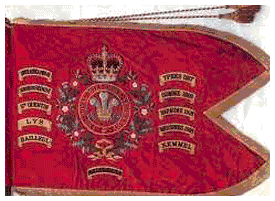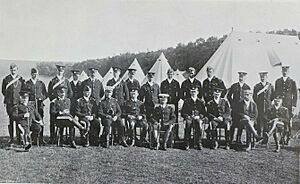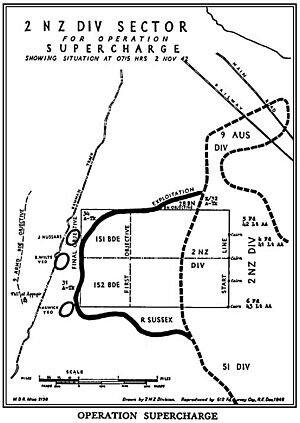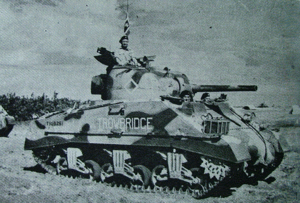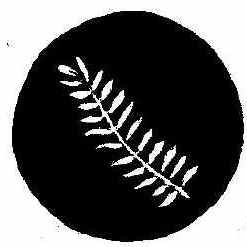Royal Wiltshire Yeomanry facts for kids
Quick facts for kids Royal Wiltshire Yeomanry (Prince of Wales's Own) |
|
|---|---|

Badge and service cap as worn at the outbreak of World War II – the cap badge is simply the Prince of Wales' feathers
|
|
| Active | 1794–present |
| Country | |
| Branch | |
| Type | Yeomanry |
| Role | Armoured reserve |
| Size | Two squadrons |
| Part of | Royal Armoured Corps |
| Garrison/HQ | Salisbury and Swindon |
| Motto(s) | Primus in Armis |
| Colours on the stable belt of the RWY. | 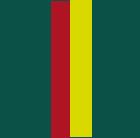 |
| Engagements | Second Boer War First World War |
| Battle honours | See battle honours below |
| Commanders | |
| Honorary Colonel | Colonel Oliver J.H. Chamberlain, QVRM, TD, DL |
The Royal Wiltshire Yeomanry (RWY) was a special type of army unit called a Yeomanry regiment in the Kingdom of Great Britain and later the United Kingdom. It was started in 1794. This regiment was a part of the Territorial Army until 1967. At that time, many similar units were made smaller.
Today, the Royal Wiltshire Yeomanry continues as two squadrons, B (Royal Wiltshire Yeomanry) and Y (Royal Wiltshire Yeomanry). These are part of the Royal Wessex Yeomanry.
The regiment fought in the Second Boer War. In the First World War, it served on the Western Front. At first, they were horse-mounted soldiers, but later they became infantry (foot soldiers). They fought in the trenches, especially in 1917 and 1918.
In the Second World War, the regiment fought in the Middle East. They saw action in Syria against French forces and also in Iraq and Iran. Later, they joined the 9th Armoured Brigade. They fought in North Africa and Italy. They were a key part of the Second Battle of El Alamein in November 1942.
The Royal Wiltshire Yeomanry's cap badge shows the Prince of Wales's feathers. Their vehicles also carry the New Zealand fern leaf symbol.
Contents
History of the Royal Wiltshire Yeomanry
How the Regiment Started
On June 4, 1794, a group of gentlemen in Devizes, Wiltshire, decided to create ten independent groups of Yeomanry. The High Sheriff, Richard Long, helped make this happen. Five men became captains in the new unit. By 1797, these groups became the Wiltshire Yeomanry Cavalry.
Yeomanry units were not meant to fight overseas. So, the regiment did not take part in the Napoleonic Wars or other wars in the 1800s. However, the Royal Wiltshire Yeomanry helped control local problems. These included a mutiny by the county's Militia and riots like the Swing Riots. Because of their service, King William IV gave them the title 'Royal' in 1831. They were the first Yeomanry regiment to get this honor.
In 1863, they escorted the Prince of Wales (who later became King Edward VII) through Savernake Forest. To recognize this, they were the first British Army regiment to be called 'Prince of Wales's Own'. This meant they could wear the Prince of Wales's feathers as their badge. In 1884, Queen Victoria placed them at the top of the new Yeomanry Order of Precedence.
Fighting in the Second Boer War
The Yeomanry units were not supposed to serve outside Britain. But after some defeats in December 1899, the British government needed more soldiers. A special order was given on December 24, 1899. This allowed volunteer forces to fight in the Second Boer War. The Royal Wiltshire Yeomanry sent three companies of about 115 men each to join the Imperial Yeomanry.
In 1900, the regiment represented the Yeomanry cavalry at the start of the Commonwealth of Australia.
On April 17, 1901, the regiment changed its name to the Royal Wiltshire Imperial Yeomanry (Prince of Wales's Own Royal Regiment). It was reorganized into four squadrons and a machine gun section. On April 1, 1908, it became the Royal Wiltshire Yeomanry (Prince of Wales's Own Royal Regiment) again. It joined the Territorial Force and was trained like hussars (light cavalry). The regiment was based in Chippenham.
The First World War (1914-1918)
When the war started in August 1914, many members volunteered to serve overseas. So, the units were split into different "Lines." The 1st Line units were for overseas service. The 2nd Line units stayed home. A 3rd Line was formed later to train new soldiers.
1st Line: Royal Wiltshire Yeomanry in France
The regiment went to France in December 1915. In 1916 and 1917, they mostly did jobs like policing, traffic control, and delivering messages. In March 1917, they had their only action as horse-mounted cavalry. This was during the German retreat to the Hindenburg Line. They tried to keep up with the retreating German soldiers. They even captured a lance from German Uhlans (cavalry).
By September 1917, it was clear that horse cavalry was not very useful on the Western Front. The regiment became infantry and joined the 6th Battalion, The Wiltshire Regiment. They fought in the trenches at Ypres and Cambrai in 1917.
In March 1918, the German army launched a big attack called the Spring Offensive. The 6th Wilts, which included many former RWY soldiers, faced the full force of this attack. After a week of fighting, they had over 500 casualties (killed or wounded). Later, the 6th Wilts was disbanded because they had lost so many soldiers. The regiment earned 13 battle honours for the First World War.
Between the World Wars
After the First World War, it was decided that there were too many cavalry units. Most Yeomanry regiments were changed into other types of units, like artillery. But the Royal Wiltshire Yeomanry was kept as a horse-mounted cavalry unit because it was the most senior.
During this time, the regiment was an important part of the county's social life. Its officers often came from noble families or landowners. The other soldiers were often from their estates. Social events and hunting were as important as military training.
In 1937, the regiment met Bernard Montgomery, a famous general. He was leading an exercise in Wiltshire. The RWY was attached to his brigade for their annual camp. At first, the Yeomanry soldiers were not keen on the tough exercises. But they became interested and asked to join the final exercise.
The Second World War (1939-1945)
The regiment started getting ready for war in August 1939, just before the Second World War began. They were sent to Palestine as part of the 1st Cavalry Division. They also served in Syria, North Africa, and Iraq. In North Africa, they worked as a searchlight unit in ports like Tobruk.
In January 1941, after 150 years, their horses were replaced by vehicles. In June, they fought successfully against French forces in Syria. They were short on equipment but still won. In July 1941, they became the 9th Armoured Brigade. They fought as motorized infantry in Persia. In December, they received their first Honey tanks and finally became an armoured regiment.
In May 1942, the regiment moved to Egypt. Their brigade became independent and worked with the 2nd New Zealand Division. This division was part of the British Eighth Army, led by Bernard Montgomery. The brigade was in reserve during the Battle of Alam el Halfa in August. In October, they trained for the Second Battle of El Alamein.
El Alamein: Operation Lightfoot
The Second Battle of El Alamein began with four divisions attacking the Axis positions in the north. The RWY supported the 5th New Zealand Brigade. The plan was for infantry to secure a ridge at night. Then, the tanks would pass through at dawn to create a shield. The regiment had a mix of M4 Sherman, Crusader, and Grant tanks.
On the morning of October 24, 1942, two squadrons of the RWY were ahead of the infantry. One squadron was delayed in minefields and lost many tanks. Throughout the day, the other squadrons fought German panzers. They were hit by anti-tank fire. The heavier Sherman tanks were safe at first, but when German 88mm anti-tank guns joined, they took heavy losses. By midday, the two squadrons had only one Sherman and three Grants left. Their commanding officer was badly wounded.
The regiment was ordered to pull back at 6 p.m. They had lost almost all their tanks and had 42 soldiers killed or wounded. They received new tanks, quickly repaired from the battlefield. General Montgomery was impressed with the 2nd New Zealand Division. He wanted them to lead the next attack.
El Alamein: Operation Supercharge
On the night of November 1-2, 1942, the Eighth Army attacked again. The 2nd New Zealand Division led the way. The goal was to attack westwards. Infantry would lead the night attack, and the 9th Armoured Brigade would break through the enemy's gun line.
The attack went as planned, but the enemy fought harder on the left. This slowed the advance. As a result, the tanks were visible against the dawn sky. They started getting hit by Axis anti-tank fire. The RWY was in the middle of the 9th Armoured Brigade. The commander of B squadron realized they were surrounded by enemy anti-tank guns. He gave the order to 'Charge'. B Squadron overran the enemy positions, losing some tanks but destroying the gun line.
After the 9th Armoured Brigade's action, the 1st Armoured Division was right behind them. But there was no communication between the units. The 1st Armoured Division did not push through the broken enemy line.
Despite this, the attack by the 2nd New Zealand Division had drawn in two German Panzer Divisions. This created a large gap in the Axis lines to the southwest. Montgomery sent the rest of his tanks through this gap. This broke the Afrika Korps line and pushed them back. By November 4, the battle was won.
Montgomery later wrote about the battle: "I must mention the magnificent fight put up by 9th Armoured Brigade... If the British armour owed any debt to the infantry of 8th army, the debt was paid on November 2nd by 9th Armoured Brigade in heroism and blood...."
Syria and Italy Campaigns
After El Alamein, the 9th Armoured Brigade moved to Cairo and then to Syria. They stayed there in 1942 and 1943 for security duties. In May 1944, they reached the Italian Front. The RWY supported the 36th Infantry Brigade. One squadron helped each of the brigade's three infantry battalions.
In May and June 1944, they took part in the advance on Rome. They moved through difficult country between the mountains and the sea. At one point, the 78th Division pulled back, but parts of the regiment did not get the message. They kept moving forward.
In July and August, the 9th Armoured Brigade supported Indian Infantry Divisions in the central mountains. In August, an order came to send home all men who had served overseas for more than 4.5 years. This cut the regiment's strength in half. It became too small to fight, so it was pulled from the front line.
In October 1944, the regiment returned to England. They trained new soldiers for other armoured regiments still fighting in Europe. They continued this role until 1946.
During the Second World War, soldiers in the regiment received many awards. These included three Distinguished Service Orders and ten Military Medals. The regiment lost 59 soldiers during the war. The biggest loss was 20 soldiers on or around November 2, 1941, during Operation Supercharge.
The Cold War Era
In 1947, the regiment stopped existing for a short time. But the next year, it was started again as a heavy tank unit. They used Cromwell and Charioteer tanks.
In 1958, the regiment changed to a light reconnaissance role. This meant they would scout ahead and gather information. They used armoured cars like the Daimler and Ferret. By 1964, there were only three armoured regiments in the Territorial Army. In 1967, the Territorial Army was made even smaller. The Royal Wiltshire Yeomanry was disbanded as an independent unit.
However, a new Territorial Army unit, the Royal Yeomanry, was formed from five older units. The Royal Wiltshire Yeomanry was reborn as A Squadron, The Royal Yeomanry.
During the Cold War, if there had been a war, their job would have been to scout for the British Army of the Rhine (BAOR). In 1971, a second Royal Wiltshire Yeomanry squadron was created. This was B squadron, Royal Wessex Yeomanry. It was for home defense and later used Land Rovers for scouting.
The Royal Wiltshire Yeomanry Today
On July 1, 2014, A (Royal Wiltshire Yeomanry) Squadron changed its name to Y (Royal Wiltshire Yeomanry) Squadron, Royal Wessex Yeomanry. Like B (Royal Wiltshire Yeomanry) Squadron, they began training on Challenger 2 tanks.
Today, the Royal Wessex Yeomanry acts as the Armoured Reserve Regiment. They provide trained crews for three regular army regiments that use the Challenger 2 main battle tank.
Battle Honours
The Royal Wiltshire Yeomanry earned the following battle honours. The ones in bold are shown on the regiment's special flag, the guidon:
| Second Boer War | South Africa 1900–01 |
| First World War | Ypres 1917, Broodseinde, Passchendaele, Somme 1918, St. Quentin, Bapaume 1918, Lys, Messines 1918, Bailleul, Kemmel, France and Flanders 1916–18 |
| Second World War | Iraq 1941, Palmyra, Syria 1941, El Alamein, North Africa 1942, Liri Valley, Advance to Tiber, Citta della Pieve, Trasimene Line, Advance to Florence, Monte Cedrone, Citta di Castello, Italy 1944 |
The regiment's battle honours are shown on the picture of the RWY guidon at the beginning of the regimental history.
Uniforms and Symbols
In the 1800s, the regiment wore different uniforms. Their jackets were always dark blue. They wore a leather shako (a tall hat) from 1812 to 1873. This was replaced by a fur Busby with a red cloth bag in 1873. During the First World War, their service uniform was a khaki tunic and breeches. It had a red stripe down the side and a red lanyard on the left arm. Sergeants and corporals had a regimental badge on a red felt backing above their rank stripes.
The regiment's colors are green, red, and yellow. These colors are on their regimental tie and Stable belt. These colors were chosen in the late 1800s.
The cap badge of the RWY is the Prince of Wales's feathers. It looks a bit different from other regiments that use the same symbol. It is worn on a brown beret with red and black felt backings. During the First World War, men from the RWY carved their cap badge into the chalk hillside above Fovant village. You can still see it there today.
The New Zealand 'fern leaf' symbol was painted on the regiment's vehicles when they were with the 2nd New Zealand Division. This tradition continues today. The brigade sign they wore during the Italian campaign was a white horse on a green square.
See also
- Imperial Yeomanry
- List of Yeomanry Regiments 1908
- Yeomanry
- Yeomanry order of precedence
- British yeomanry during the First World War
- Second line yeomanry regiments of the British Army


